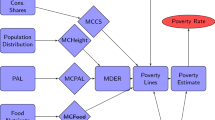Abstract
This paper aims to present a new global poverty line based on the 2011 Purchasing Power Parity (PPP). To calculate a new global poverty threshold based on 2011 PPP, this paper moves away from the World Bank’s method of anchoring a single global poverty line on the national poverty lines of the 15 poorest countries. It instead proposes an alternative method of using equivalent poverty lines. Each country is shown to have a different equivalent poverty line. This paper finds that there is no single international poverty line in 2011 PPP that is equivalent to $1.25 in 2005 PPP. Single poverty lines vary for each region because countries have experienced different inflation rates and have different PPP conversion rates between 2005 and 2011. To calculate a single poverty line in 2011 PPP, this paper measures the weighted average of equivalent poverty lines of 101 countries around the globe with weights proportional to their populations. Based on the new method, the corresponding poverty line is estimated at $1.93 in 2011 PPP. The World Bank has officially adopted the poverty line of $1.90 in 2011 PPP. This paper demonstrates that our proposed poverty line performs better than the World Bank’s in terms of preserving the real purchasing power of the previous line of $1.25 in 2005 PPP. Given the new poverty threshold of $1.93, the number of poor worldwide is reduced by 6.42 million, with the reduction largely occurring in South Asia and Sub-Saharan Africa.
Similar content being viewed by others
References
Bluhm, R., Crombrugghe, D., Szirmai, A.: Poor trends – The pace of poverty reduction after the millennium development agenda. MERIT Working Papers 006 United Nations University – Maastricht Economic and Social Research Institute on Innovation and Technology (2014)
Deaton, A.: Price indexes, inequality, and the measurement of world poverty. Am. Econ. Rev. 100(1), 1–34 (2010)
Ferreira, F., Chen, S., Dabalen, A., Dikhanov, Y., Hamadeh, N., Jolliffe, D., Narayan, A., Prydz, E., Revenga, A., Sangraula, P., Serajuddin, U., Yoshida, N.: A global count of the extreme poor in 2012: data issues, methodology and initial results. Policy research Working Paper 7432. World Bank, Washington D.C. (2016)
Jolliffe, D., Prydz, E.: Global poverty goals and prices: how purchasing poverty matters. Policy Research Working Paper 7256. World Bank, Washington D.C. (2015)
Author information
Authors and Affiliations
Corresponding author
Electronic supplementary material
Below is the link to the electronic supplementary material.
Rights and permissions
About this article
Cite this article
Kakwani, N., Son, H.H. Global poverty estimates based on 2011 purchasing power parity: where should the new poverty line be drawn?. J Econ Inequal 14, 173–184 (2016). https://doi.org/10.1007/s10888-016-9322-x
Received:
Accepted:
Published:
Issue Date:
DOI: https://doi.org/10.1007/s10888-016-9322-x



